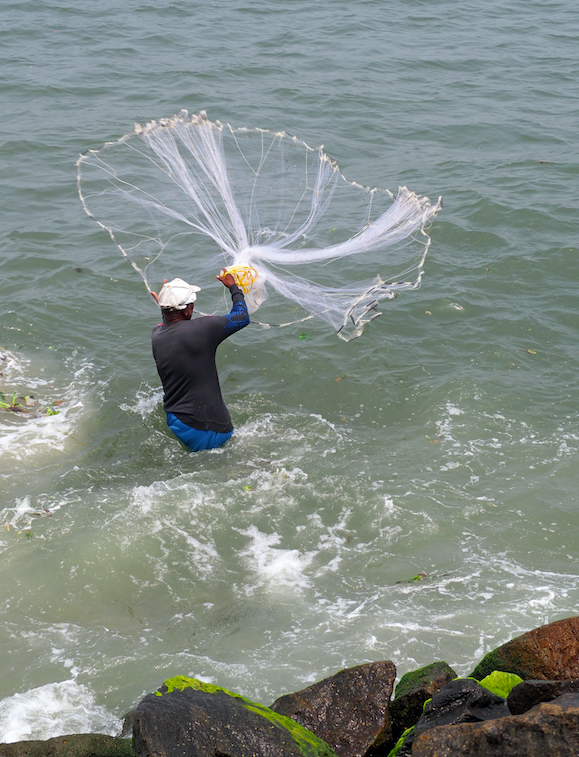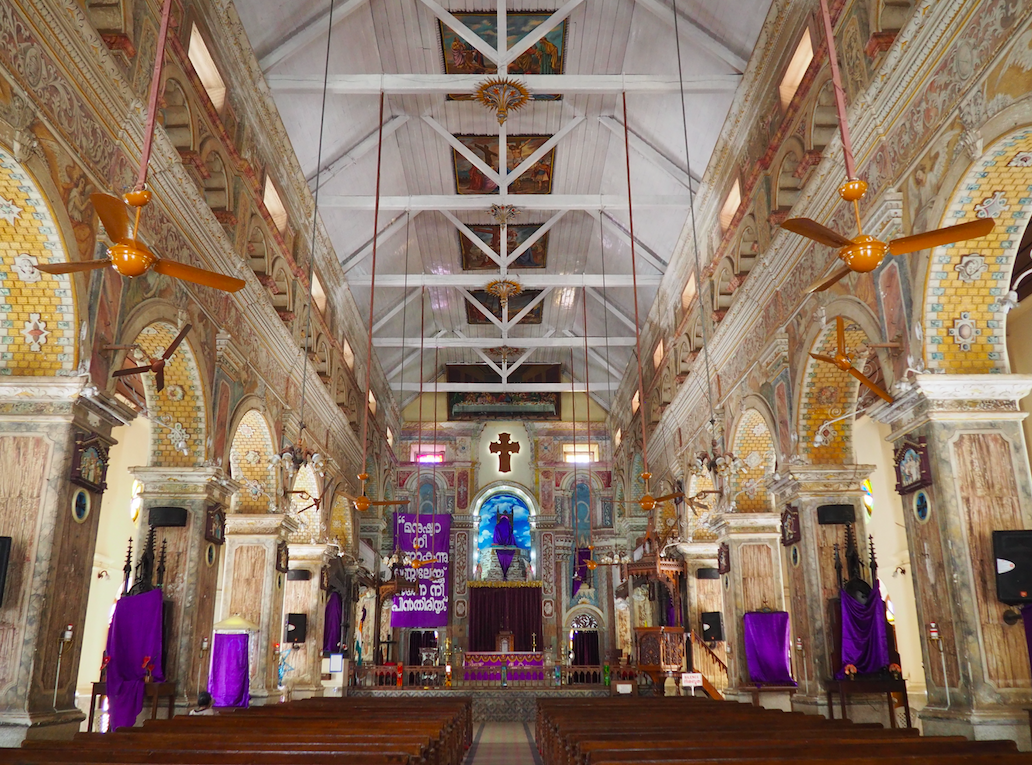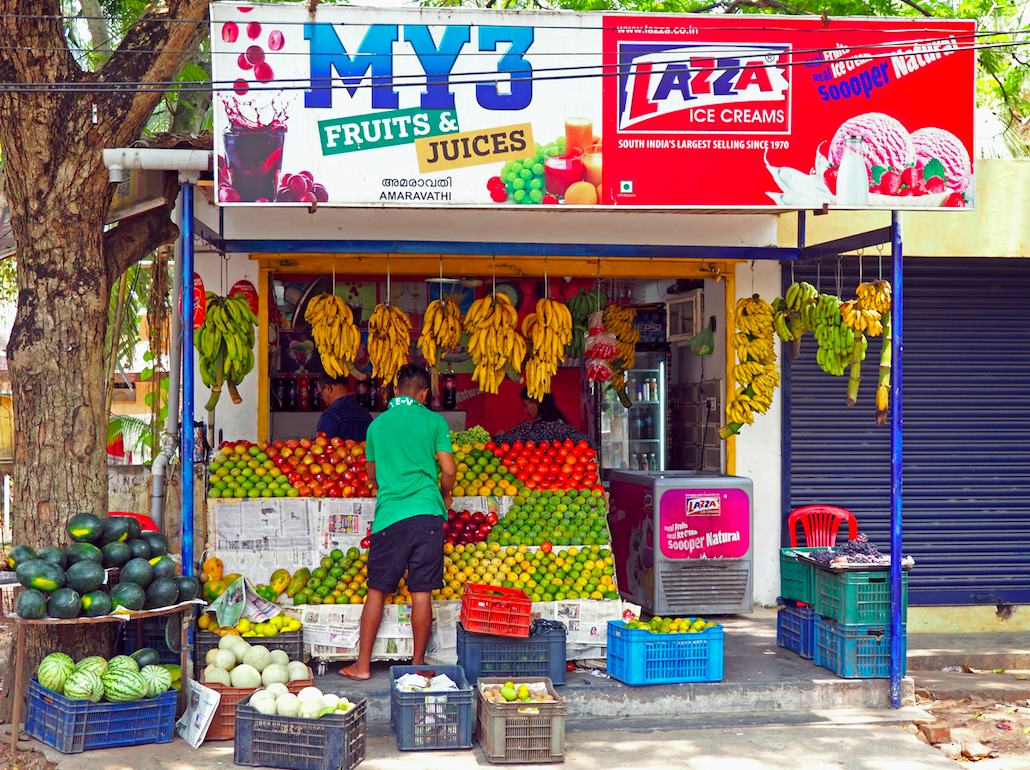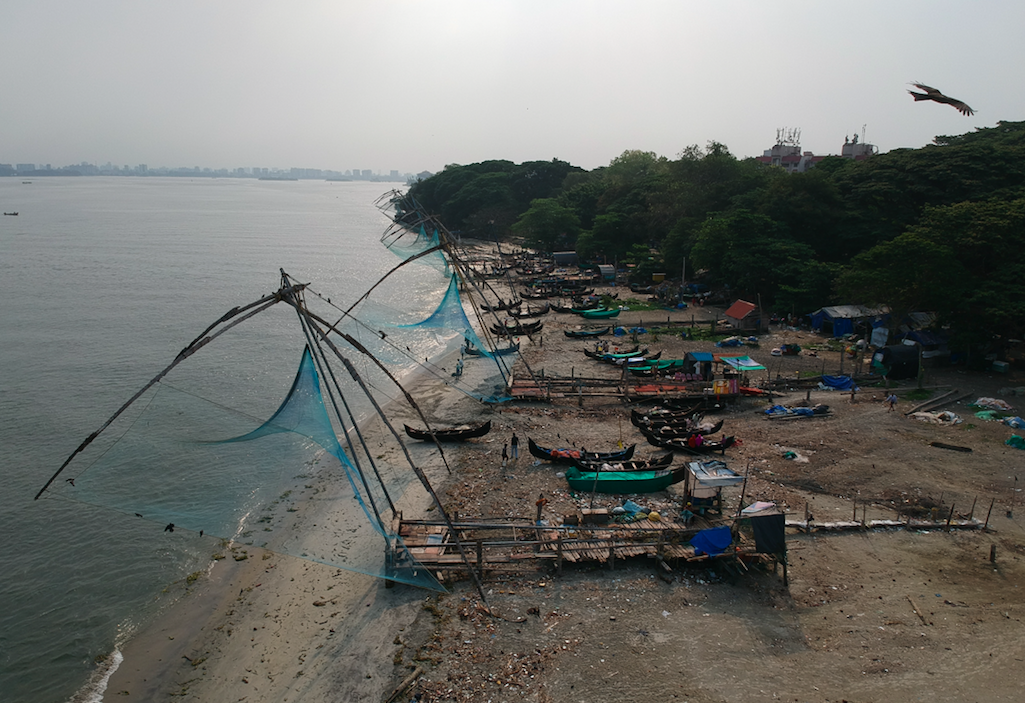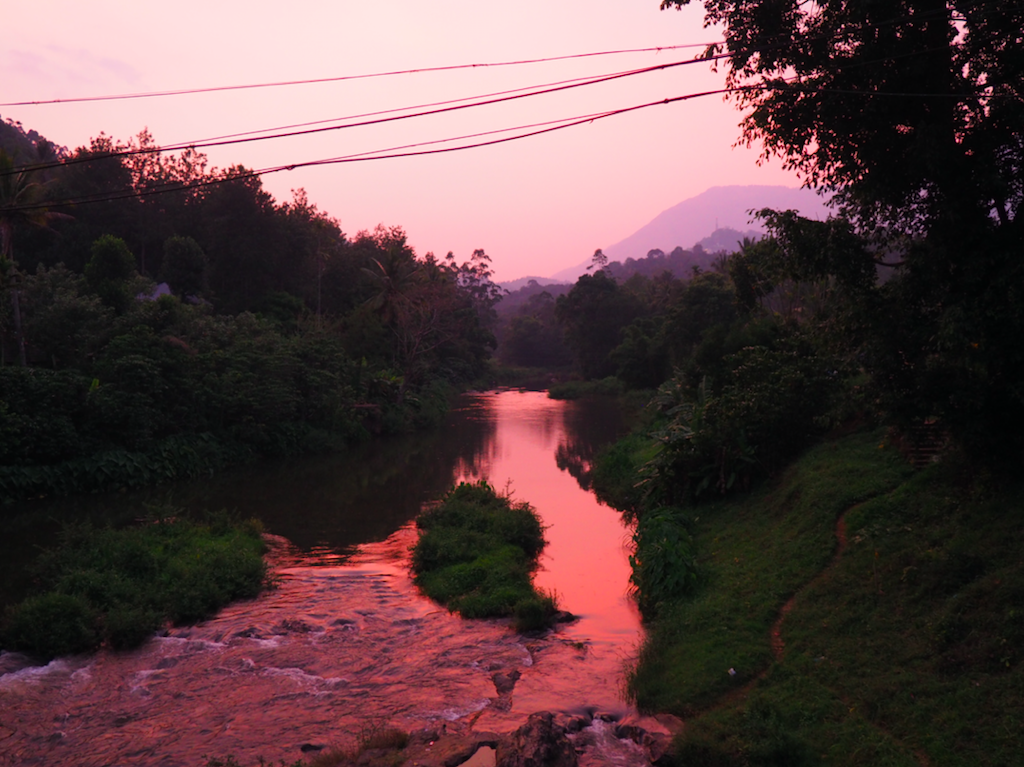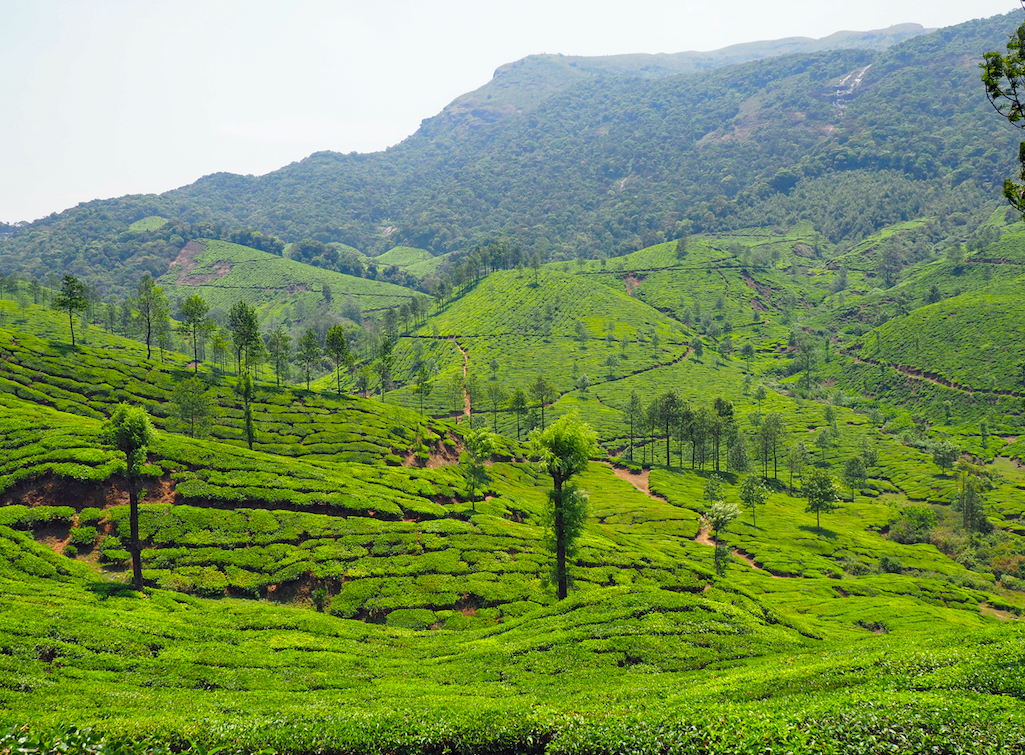On the way out of Bangalore, Stefje and I piled all our luggage on the side of a highway on the outskirts of the city. Although it felt similar to our hitchhiking adventures, this time we were traveling in the lap of luxury. Soon enough our bus pulled up and we climbed into a spacious lay flat bed where we promptly passed out for the next 9 hours.
In the morning we were in Fort Kochin, a tiny peninsular the has served as one of India’s most important and well-protected ports for centuries. Today the economy revolves around two intertwined sectors, fishing and tourism.
Eager to see what the city had to offer, we set off to do what we do best in a new city: explore on foot, take pictures and find delectable cheap eats. Our noses led us towards the wafting fragrances of salty sea breezes. On the docks surrounding the city, fishermen were prominent. Spinning in 360 degree turns to unleash nets amidst waist-high waves, their physical strength was clear.
Yet signs of their demise abounded. In the distance, trawlers carted off catches hundreds of times larger than their nets could manage. In the foreground, plastic floated in the waves. During our time observing the situation, we sadly witnessed the men catch more trash than fish.
Further along the dock, we came across the picturesque highlight of Kochin, the Chinese fishing nets. These impressively engineered contraptions consist of a weighted system which slowly lowers a vast net into the water, requiring at least four men to pull it back skyward. While the nets dipped below the surface, birds eager for a morning snack roosted upon the arms, which are just tree limbs tied together with rope.
As awesome as the sight was, I couldn’t help but feel perturbed by the broader environment. Frighteningly few fish were raised from the sea and each time we walked by a net the fisherman attempted to enlist us to pull it with them, clearly searching for a supplemental second income.
All along the dock tiny carts abounded, selling ridiculously plastic toys and objectively useless souvenirs. Clearly the economy here is changing with the advent of tourism, but it might not be for the better.
To me the most interesting aspect of Kochin was the intersectionality of religions. Evidenced by young girls wearing Catholic school uniforms, prominent signs pointing towards “Jew Town” and India’s oldest synagogue, muslim mosques issuing the call to prayer, and plenty of Hindu offerings lining the streets, the tiny city is the ultimate melting pot of worshippers.
The most striking religious building was the town’s cathedral, which was originally constructed a shocking 500 years ago in 1505.
The city retains more aspects of its Portuguese and Dutch colonial past, which was especially visible through the architecture. We noticed an intriguing mix of old and new and recently refurbished. For every classically designed homestay with colonial archways and a manicured inner courtyard, there was another building from the same era badly in need of renovations. Yet the narrow alleyways were also home to many modern buildings, leaving Stefje and I wondering what cycles of boom and bust have gripped the town throughout the last few decades.
Our walk continued past art cafes, homestays and restaurants, then eventually we escaped the enclave of tourism. Suddenly, shops and houses lined crowded streets. Prices dropped, chaos reigned and we happily immersed ourselves in the oddities of the neighborhood while intense humidity formed a layer of perspiration on our skin.
The next morning we returned to the docks to catch a glimpse of the Chinese fishing nets in action. Contrasted with the contrived tourism of the day before, the day got off to a much better start. While young boys played soccer on the beach before the heat became unbearable, the nets hauled in catches and fisherman auctioned off their booty on the dock.
Later in the day we opted for a detour on our itinerary, taking the local route eastward into the hills of Munnar. This meant taking a tuk-tuk, a ferry, and another tuk-tuk just to reach the local bus station. Here we clamored aboard an open-air bus, which meant a refreshing breeze accompanied us for the next 5 hours as we stuck our heads out the windows.
The route began in the city of Kochin, with an urban sprawl and seemingly endless columns of tightly bunched traffic. But eventually the buildings started to disperse, the empty spaces filled with trees, and after a few hours we were winding through wooded hillsides with scarcely a rural village in sight.
The air quality improvement was immediately transparent. I gulped in long breaths of the crisp mountain air, enabling the forest to rejuvenate my senses. The journey culminated with a sunset view of the river that rushed directly beneath our guesthouse, as we traded honking trucks for tumbling waters.
So complete was our solitude that the night we were able to sleep without earplugs for the first time in India.
On Sunday morning our breakfast was framed by a mountain and a luscious garden featuring flowers with shades of purple, gold, red and yellow. The scenery foreshadowed a spectacular day in nature. An hour long bus ride from our guesthouse into the town of Munnar brought us through gorgeous rolling hillsides dotted with teal plantations and vegetable farms before depositing us in the dirty and hectic city center. But soon enough we were aboard a rented scooter, whizzing again through a calm country road.
This time we were free to stop whenever a beautiful view was available, which was more or less every five minutes for the first hour.
Entire villages of tea plantation workers laid out their colorful wash framed beautifully by steep terraced hillsides.
Everywhere we turned, the tea bushes flourished, curving with the counters of the undulating hills.
The whole morning there was hardly a stretch of 50 feet where the road was straight; we turned back and forth with reckless abandon up a mountain pass. Eventually the route yielded stunning panoramas gazing out over the valley behind us.
At scale, it seemed as though every shade of green was represented in the flora of this bountiful paradise.
Eventually some of the mountains were too steep or too high to be cultivated, which meant that trees abounded. From a distance, their canopies swayed in the wind like a crowd at a concert.
To our left, a steep bald mountaintop appeared, one of the highest points in all of Southern India. The wind started coming through with a slight chill as we approached the pass, accompanied by tremendous sweeping views in every direction.
At the top we stopped at a makeshift stand, enjoying a cup of weak coffee, an unripe mango, and a “bread omelette” (literally bread wrapped in scrambled eggs) while conversing with the proprietors.
From here we turned back towards town, barely opening the throttle while hugging each downhill turn. In Munnar we stopped for a resplendent meal of all you can eat rice and curry at a popular local establishment, then chose a new road out of town for our afternoon jaunt.
This path was exponentially more popular among the domestic tourists. Each of the top attractions was quickly betrayed by the standard blue tarp shacks which lined the sides of the road. In addition to freshly brewed tea, the local delicacies for sale here were spices, homemade chocolate, carrots, and high piles of raw beetroot.
For the shameless tourist, anything was possible: selfies next to a man-made lake, selfies inside a botanical garden, even selfies atop a costumed elephant. As you can tell, Indian tourism revolves around taking lots of pictures of yourself, preferably in a large group of a dozen or more.
Not to be outdone, we snapped a few photos of our own from inside the tea plantations.
As the road wore on, my jaw defaulted to a slacked state. I caught myself audibly saying “whoa” no less than a dozen times when a tight turn or steep cliff revealed more of the beautiful countryside.
An hour of driving later we made it to top station, which serves as the dividing line between the regions of Kerala and Tamil Nadu. Endless undulating greenery swept across our view, the details shrouded sight that seemed worthy of a fantasy movie.
Our eyes gazed deep into the distance, astonished by the steep mountains rising out of the misty landscape. Just as it was the culmination of our climb, it was the high point of our day.
Soon we reversed course and slowly cruised back into town, enjoying every minute of our time amidst such surroundings.


